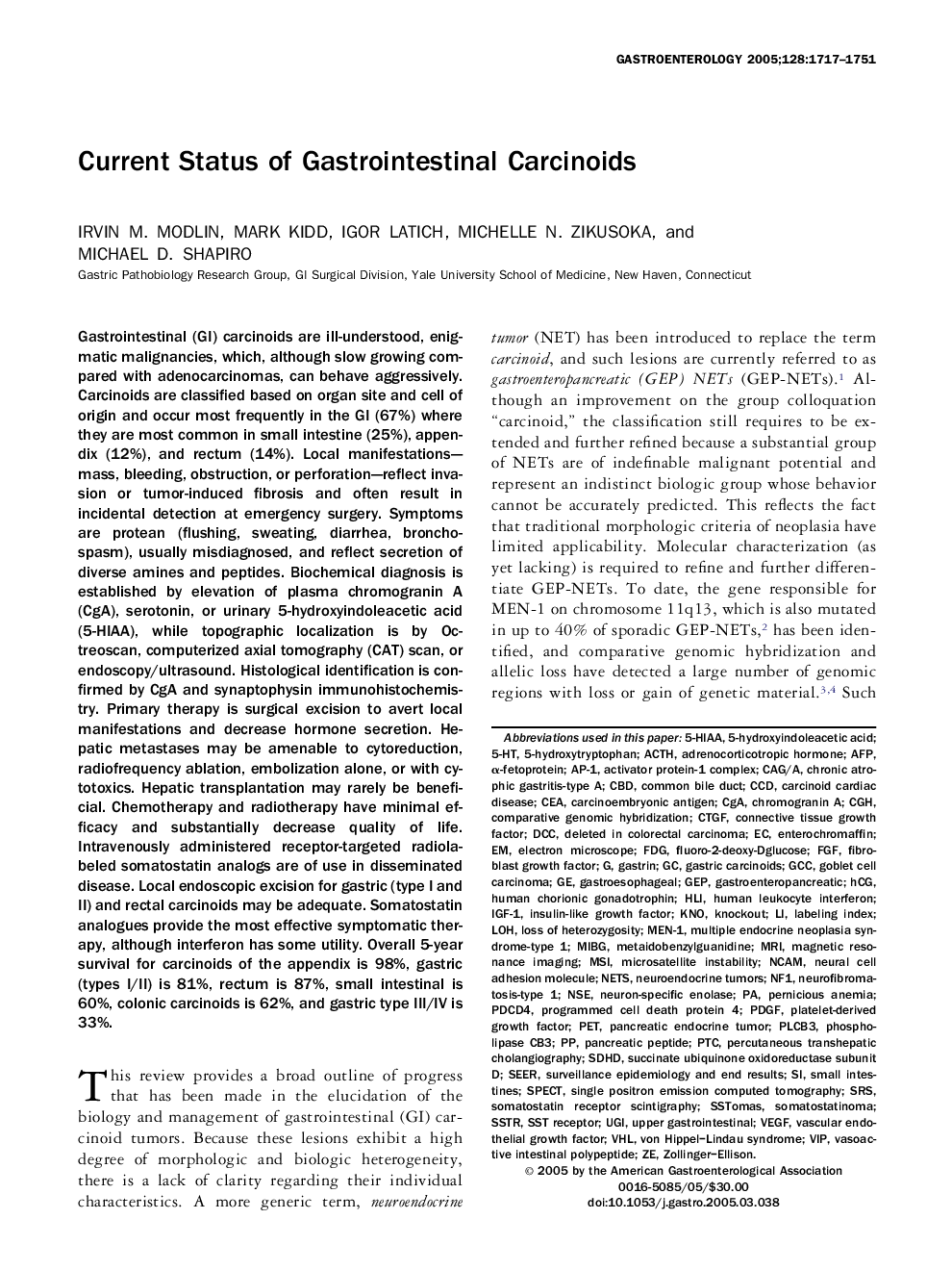| کد مقاله | کد نشریه | سال انتشار | مقاله انگلیسی | نسخه تمام متن |
|---|---|---|---|---|
| 9244275 | 1209908 | 2005 | 35 صفحه PDF | دانلود رایگان |
عنوان انگلیسی مقاله ISI
Current Status of Gastrointestinal Carcinoids
دانلود مقاله + سفارش ترجمه
دانلود مقاله ISI انگلیسی
رایگان برای ایرانیان
کلمات کلیدی
MSIAP-15-HIAA5-hydroxytryptophanFDGSmall intestinesNF1DCCSSTRNCAMPDGF5-HTVHLGEPGCCCGHPDCD4SDHDknoHLIMEN-1UGIIGF-1NSECBDACTHDeleted in colorectal carcinomaFGFCTGFCGAVIPSRSCCDPTC5-Hydroxyindoleacetic acid - 5-هیدروکسی سدیم اسیدCeA - CEANeuron-specific enolase - enolase اختصاصی نورونNETs - NET هاα-fetoprotein - α-فتو پروتئینcarcinoembryonic antigen - آنتی ژن carcinoembryonicloss of heterozygosity - از دست دادن هتروزیگوتیسمMRI - امآرآی یا تصویرسازی تشدید مغناطیسیenterochromaffin - انتروکرومافینSurveillance Epidemiology and End Results - اپیدمیولوژی نظارت و نتایج پایانHCG - اچ سی جیSPECT - برشنگاری رایانهای تک فوتونی، مقطع نگاری رایانهای تک فوتونی، توموگرافی رایانهای تک فوتونی، اسپکتMicrosatellite instability - بی ثباتی ریزماهواره ایcomparative genomic hybridization - ترکیب هیبریداسیون ژنومی مقایسه شدهAFP - تست AFP یا آلفا فیتو پروتئینMagnetic resonance imaging - تصویربرداری رزونانس مغناطیسیPancreatic endocrine tumor - تومور غدد درون ریز پانکراسneuroendocrine tumors - تومورهای نوروندوکرینgastroesophageal - دستگاه گوارشSEER - سرندSomatostatinoma - سموتوستاتینوماVon Hippel-Lindau syndrome - سندرم فون هیپال-لیندائوSomatostatin receptor scintigraphy - سینتیگرافی گیرنده سموتوستاتینlabeling index - شاخص برچسب زدنVascular endothelial growth factor - فاکتور رشد اندوتلیال عروقیVascular Endothelial Growth Factor (VEGF) - فاکتور رشد اندوتلیال عروقی (VEGF)Connective tissue growth factor - فاکتور رشد بافت همبندplatelet-derived growth factor - فاکتور رشد حاصل از پلاکتfibroblast growth factor - فاکتور رشد فیبروبلاستInsulin-like growth factor - فاکتور رشد مانند انسولینMIBG - فرستادهLOH - لوهانcommon bile duct - مجرای صفراوی مشترکneural cell adhesion molecule - مولکول چسبندگی سلولی عصبیElectron microscope - میکروسکوپ الکترونیknockout - ناکاوتadrenocorticotropic hormone - هورمون adrenocorticotropicPET - پتprogrammed cell death protein 4 - پروتئین مرگ سلولی برنامه ریزی شده 4Vasoactive intestinal polypeptide - پلیپپتید روده روغنیChromogranin A - کروموگرانین Apernicious anemia - کم خونی فقر آهنpercutaneous transhepatic cholangiography - کولانژیوگرافی بینابینی کبدیGastroenteropancreatic - گاستروانترپانکراسیgastrin - گاسترینhuman chorionic gonadotrophin - گنادوتروپین کوریونی انسانUpper gastrointestinal - گوارش فوقانی
موضوعات مرتبط
علوم پزشکی و سلامت
پزشکی و دندانپزشکی
بیماریهای گوارشی
پیش نمایش صفحه اول مقاله

چکیده انگلیسی
Gastrointestinal (GI) carcinoids are ill-understood, enigmatic malignancies, which, although slow growing compared with adenocarcinomas, can behave aggressively. Carcinoids are classified based on organ site and cell of origin and occur most frequently in the GI (67%) where they are most common in small intestine (25%), appendix (12%), and rectum (14%). Local manifestations-mass, bleeding, obstruction, or perforation-reflect invasion or tumor-induced fibrosis and often result in incidental detection at emergency surgery. Symptoms are protean (flushing, sweating, diarrhea, bronchospasm), usually misdiagnosed, and reflect secretion of diverse amines and peptides. Biochemical diagnosis is established by elevation of plasma chromogranin A (CgA), serotonin, or urinary 5-hydroxyindoleacetic acid (5-HIAA), while topographic localization is by Octreoscan, computerized axial tomography (CAT) scan, or endoscopy/ultrasound. Histological identification is confirmed by CgA and synaptophysin immunohistochemistry. Primary therapy is surgical excision to avert local manifestations and decrease hormone secretion. Hepatic metastases may be amenable to cytoreduction, radiofrequency ablation, embolization alone, or with cytotoxics. Hepatic transplantation may rarely be beneficial. Chemotherapy and radiotherapy have minimal efficacy and substantially decrease quality of life. Intravenously administered receptor-targeted radiolabeled somatostatin analogs are of use in disseminated disease. Local endoscopic excision for gastric (type I and II) and rectal carcinoids may be adequate. Somatostatin analogues provide the most effective symptomatic therapy, although interferon has some utility. Overall 5-year survival for carcinoids of the appendix is 98%, gastric (types I/II) is 81%, rectum is 87%, small intestinal is 60%, colonic carcinoids is 62%, and gastric type III/IV is 33%.
ناشر
Database: Elsevier - ScienceDirect (ساینس دایرکت)
Journal: Gastroenterology - Volume 128, Issue 6, May 2005, Pages 1717-1751
Journal: Gastroenterology - Volume 128, Issue 6, May 2005, Pages 1717-1751
نویسندگان
Irvin M. Modlin, Mark Kidd, Igor Latich, Michelle N. Zikusoka, Michael D. Shapiro,